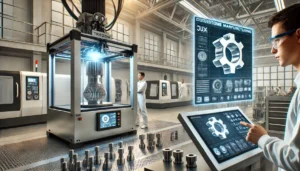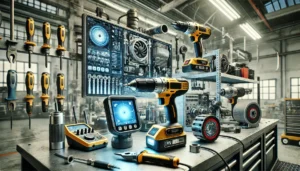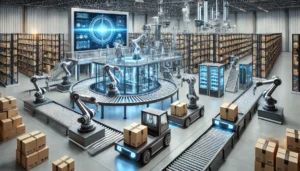A new demand has sprouted for personalized services and products without unduly increasing the cost or waiting time. This demand has been met via the concept of mass customization. Mass Customization is a hybrid manufacturing framework that incorporates mass management based processes with customized tailoring at the end. To achieve mass customization, there has to be FMS (Flexible Manufacturing Systems) which allow for effective responses to changes in product complexity and production quantity.
An Overview of FMS (Flexible Manufacturing System)
FMS is defined as an approach that integrates computer controlled work stencil machines, automated storage, and conveyor systems to make many different products with dummy handwork. FMS’s main focus is on when multiple parts or products need to be controlled, with constant changeovers and downtime, together with quick minutes. This sort of flexibility is vital for producers who wish to target niche markets and offer customized products, while not compromising on the mass production strategy.
Key Components of FMS:
- Processing Workstations: These include machines that utilize CNC technology and other automated systems to perform various functions on a specific component.
- Automated Material Handling System: AGVs or robots, together with conveyors, that move materials between workstations.
- Computer Control System: An integration system that controls machine operation, materials movement, and scheduling for efficient coordination and integration.
- Flexible Tooling: Fixtures and tools that can be changed quickly and easily to different products.
Implementing FMS for Mass Customization
For efficient implementation of FMS for mass customization, the following techniques can be employed by the various manufacturers.
1. Modular Product Design
Adopt a modular product design approach for easier interchanging and customization of components. This design approach reduces the difficulty of the manufacturing process because it is easy to change the configurations of the products without changing the production line. For example, the automobile industry has many car models that utilize the same manufacturing platform which enables them to produce various models at the same time.
2. Advanced Manufacturing Technologies
Purchase 3D printers, CNC machines, and robots to allow more freedom in the production processes. These technologies allow the manufacture of customized components within a short time frame because they do not need special setup tools. For instance, 3D printing enables the production of customized and complex parts much faster than traditional methods.
3. Integration of Data in Real-time
Create a holistic integrated information system that gathers and evaluates information from different levels of the production procedures. This information can help make better decisions, allocate resources appropriately, and respond swiftly to customer requests. By tracking machine utilization and product quality in real-time, manufacturers can resolve quality problems and reduce production problems with high speed, maintaining adequate quality as well as minimizing downtime.
4. Training and Involvement of Employees
Develop the employee skills relevant to the operation and maintenance of modern manufacturing systems. Engaging employees on change with a “bottom-up approach” encourages innovation and acceptance of change in demographic challenges. Conducting training on the current state of manufacturing techniques and motivating employees to offer changes to process can yield improvement in efficiency and quality of products.
5. Collaboration with Suppliers
Form strong relationships with suppliers for the timely provision of quality materials and components. A collaborative approach by suppliers can help align the supply chain and therefore reduce the lead time and improve the responsiveness to requirements. Suppliers can make effective plans factoring in the production calendars and demand forecasts shared by the business without excessive material purchases.
Problems Faced in FMS Implementation
1. Requirements of Big Capital Expenditure
Although an FMS provides huge benefits, its adoption poses significant challenges. Even the cost of initiating an FMS through advanced machinery purchase, software integration, and employee training is rather expensive. Moreover, justifying this cost is seemingly quite difficult, as the return on investment does not occur immediately; only over time as the organization becomes more flexible, efficient, and customer satisfaction rises.
2. Requirement of Improvement in System Interconnection
The interconnection of multiple parts of an FMS into one is a delicate task that will need to be properly scheduled and executed. In addition, for the system to operate at its most productive level of efficiency, machines, control systems, and humans have to communicate with each other seamlessly. The application of communication standards and protocols facilitates the integration and interoperability of the various components of the system.
3. Regular Breakdown Maintenance and Activity Downtime
Highly mechanized systems should be maintained periodically over maintenance intervals. On top of that, unscheduled downtimes can severely compromise the production schedule and in the worst case even fail to fulfill promises made to clients. Strategies such as condition based maintenance where maintenance activities are scheduled based on the actual state of the machine will reduce downtime as well as prolong the lifespan of the equipment and machinery.
4. Supply Chain Coordination
To achieve mass customization, a supply chain must be responsive and flexible. The coordination of multiple suppliers as a means to guarantee the timely availability of several components presents a challenge. Supplier relationship management and collaborative planning processes can improve the responsiveness and flexibility of the supply chain.
Case Study: Gantri 3D Lighting Customization Technology
Gantri, a provider of lighting products, is a perfect example of the use of flexible manufacturing for mass customization. Gantri enables its customers to 3D print lamps that can be customized in terms of design, color, and finishing, which gives endless combinations in excess of 4000. With this business model, Gantri can efficiently meet the demands of the customers without the limitations of standard manufacturing processes.
Future Trends in FMS and Mass Customization
The manufacturing environment is ever changing and new trends are bound to arise that will bolster the cooperation between FMS and mass customization:
1. Artificial Intelligence and Machine Learning
AI and machine learning have the potential to transform the way manufacturers design and operate their systems. With the deployment of AI and machine learning, faster and smarter decision-making, predictive maintenance, and process analytics can be achieved. Always-on AI can help preemptively maintain systems by predicting failing equipment before they break down and prompt unexpected downtime.
2. Cloud-Based Manufacturing
Cloud computing allows manufacturers to manage and coordinate flexible production networks more effectively. Cloud-based platforms enable collaboration, production monitoring, and tracking to occur in real time, which translates to better system efficiency.
3. Digital Twins
Digital twin technology is rapidly emerging as an essential component of flexible manufacturing systems FMS for its ability to create digital counterparts of actual manufacturing systems. These models enable testing, process simulation, and optimization of processes prior to execution, mitigating expensive mistakes, and enhancing productivity.
4. Customization on Demand
Various advancements in manufacturing technology have led to companies being able to provide developed products with virtually no lead time. The fusion of AI-assisted CAD, agile instrument making, and smart factories make true customization on demand possible.
5. Robotics and Automation Expansion
The introduction of adaptive robots capable of performing multiple tasks and rearranging production lines will increase greatly. These systems are aimed to improve productivity and satisfy the ever-increasing needs for personalized products.
Conclusion
The incorporation of computers in the Flexible Manufacturing Systems has demonstrated its importance in meeting the ever-changing demands for mass customization in new innovative ways. The use of advanced technologies coupled with the IoT permits effective real-time data monitoring, integration of supply chains, and mass customization of goods, all while keeping the cost under control. In spite of issues such as high investment and complexity of the system, the long term advantages outweigh the costs, making FMS along with the automation of factories a significant part for future manufacturing systems. With the development of AI, IoT, and robotics, the demand and the importance of flexible manufacturing in satisfying customer expectations will continue to increase.










